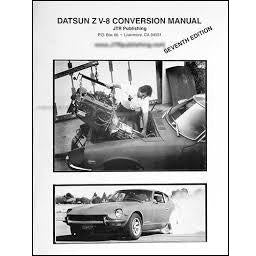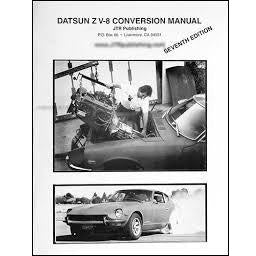Office
V-8 Conversion Manual for Datsun Z Cars
V-8 Conversion Manual for Datsun Z Cars
Couldn't load pickup availability
Overview: The Seventh Edition of this 120 page illustrated guide written by Mike Knell shows how to install the small block Chevrolet V-8 into 1970-1978 Datsun Z cars. See the excerpt from the introduction below.
The book also explains the many JTR Stealth parts designed to support the Datsun Z Car conversion to a V8.
What it Covers: The book is a complete guide including dimensioned illustrations of our motor mounts and instruction on tachometer calibration. It also includes a chapter on suspension modifications to improve the handling and braking of the V-8 Z.

No wonder the Datsun Z V-8 conversion is a popular swap! The Chevrolet small-block fits in the engine compartment so well, one wonders if Datsun had dreams of installing the Chevrolet V-8.
Now some Datsun Z owners very much disapprove of putting a V-8 into a Z car, but most have never even driven a V-8 Z. They feel that a V-8 conversion is cheating, an unfair way to increase horsepower. They may even make claims that the Z engine can be modified to produce as much power as a Chevrolet V-8. They are right, but only if the Z engine is so modified that it is virtually undriveable on the street, and they are comparing it to a stock, low-performance V-8.
Most people who modify their Z motors end up installing a larger radiator, exhaust system, and lower gear ratios in the differential. They then add a set of triple Weber (or Mikuni) carburetors, headers, a high-performance cam, and a ported cylinder head. Pretty soon, they have spent more than the cost of a V-8 conversion. And... the V-8 car will still be faster, quieter, more driveable, and it can be smog legal in the state of California (other states will soon have smog laws similar to California).
And forget about turbocharging or supercharging the Datsun 6-cylinder engine. Not only do the aftermarket turbochargers and superchargers for the Z cars add at least 50 lbs to the front of the car, they rarely work as advertised—poor drivability and durability are the norm. With the boost levels required to match the power of the V-8, you can forget about any kind of reliability. If you decide to add an intercooler, add another 30 lbs. The V-8 swap can actually be less than the cost of the turbocharger or supercharger kits.
The typical weight gain from the V-8 conversion (about 125 lbs.) is less weight than the average passenger, barely noticeable in a properly converted car, and the performance of a stock Chevrolet V-8 in a Z car is amazing.
A 260Z with a 1977 350 V-8 rated at 180 horsepower and a late model automatic overdrive transmission will do 0 to 60 mph in under seven seconds and get over 22 mpg on the highway. 240Z's are even quicker! A car with stick shift will take a bit over seven seconds to reach 60 mph because of the time it takes to shift gears and because of the difficulty in getting a good start without spinning the tires. Automatic transmissions are quicker in drag racing, but the stick shift cars perform better in road racing.
The 1970 V-8 Z shown has a 1971 350 V-8 with a gross horsepower rating of 270 horsepower (1972 and newer engines are rated at "net" horsepower, with all accessories, emissions equipment and exhaust installed. The "net" rating of the 1971 engine is about 200 horsepower).
California no longer requires smog inspections on 1973 and older cars, so any V-8 can be installed in 1970–1973 240 Z's without having to go through an emissions test.
You can see below how simple the V-8 installation appears. It does not look cluttered or complicated, even though the engine displaces 204 cubic inches more than the original motor. Nothing is dangling loose, everything is secure and orderly. It looks factory installed.

Don't let the simple, plain appearance fool you. Many hours of experimenting and testing have gone into making the conversion look this way. The engine is set back so that the distributor is about a half inch from the firewall, and it sits low enough for a stock height air cleaner to be used under the stock hood. The hoses going into the fender well are for the charcoal canister, which was relocated to the wheel well. The cooling system uses a Chevrolet radiator support, fan shroud, fan blade, hoses, and a Chevrolet radiator.
The car gained 140 lbs from the V-8 conversion; 100 lbs on the front, and 40 lbs on the rear.
If you wanted to reduce the weight gain from the V-8 conversion, an aluminum intake manifold and headers would reduce the weight on the front wheels by about 30 lbs, as well as increase power. An aluminum water pump would drop another 6 lbs. A gear-reduction starter would save 9 lbs. A lightweight flywheel would save 9 lbs. Aluminum heads would save about 40 lbs. An aluminum radiator could save another 10 lbs. The alternator could be replaced with a CS series used on the 1987 TPI Camaro and save another 2 lbs. The headlights could be replaced with plastic headlights now available at auto parts stores, they save about 2 lbs per pair. Relocating the battery to the rear would transfer an additional 35 lbs from the front of the car. If you did all of the above, the car would weigh nearly the same as a stock Z car.
Share


